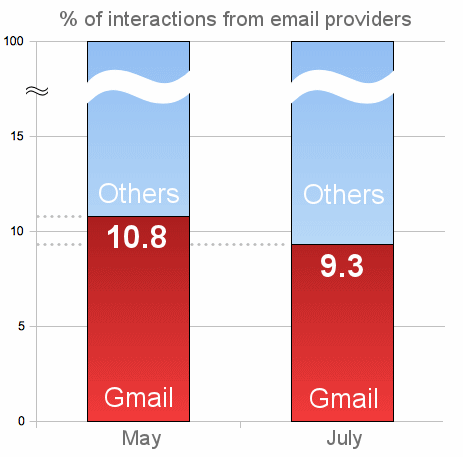There has been a great deal of online debate and discussion surrounding the new Gmail layout.
As you may know, Gmail recently introduced tabs that users can use to sort their incoming messages. This new feature includes “Promotions”, a tab designed to hold bulk emails, including the newsletters, blog posts and special offers that email marketers use to promote their products.
The update, announced last May on the official Google blog, and then released on a rolling basis in the following months, has been welcomed with caution by industry insiders. There are also some who have been extremely critical of the move. According to some marketers, Google just “killed” email marketing.
The biggest concern is that this new interface, which includes a clear separation between promotional and personal emails, will mean a considerable decrease in open rates, and that in the long term, it will lead to a substantial decrease in the overall success of many email marketing campaigns.
But is this really the case?
Some of the biggest players in the email marketing world have performed their own studies on the issue. We decided to perform our own analysis too, using the big data already archived by our email tracking system, TrackReports. We were curious to see if our results would be in line with the results found by others in the industry.
TrackReports is an online email tracking tool – available free of charge to users of SendBlaster. It allows marketers to monitor a number of important metrics, making it easier to adjust future mailings for greater effectiveness and higher open rates.
Every time recipients open an email message or click on a link, TrackReports updates its internal database and creates a set of stats, both textual and graphs.
METHOD OF ANALYSIS
For our analysis we could compare email open rates in May (before the introduction of the new Gmail tabs) to those for July. But the problem with that approach is that this kind of analysis could be affected by normal seasonal trends. In fact, it is normal for open rates to decrease during the summer season, regardless of updates or new features coming from email providers.
In order to prevent distortions, we have adopted a different metric, which is not affected by seasonal trends. We call it “unique interactions rate”. This is defined as the percentage of unique actions coming from a specific email service. Simply put, we considered all unique actions – including clicks and opens – taken by recipients who received at leaste one email message tracked by TrackReports.
We then applied this metric to 3,000,000 unique interactions monitored by TrackReports, one in May and one in July. To avoid distortions we have limited our analysis to unique interactions – our analysis did not take repeated clicks or opens into account.
Our analysis also considered other data for the past months just to ensure that we were comparing similar data.
In fact, we calculated the coefficient of variation for the past period, and we found that the values were pretty constant (+/- 0,6%). That information confirmed to us that the kind and amount of data we considered for our analysis was reliable.
FINDINGS
We found that the average interaction rate before the new Gmail – in May – was 10.8%, while the interaction rate after the release was 9.3% – a drop of 1,5% – that corresponds to 14 %.

Speaking of open rates, this means that marketers who had been enjoying an average open rate of 20% can expect to see that rate drop to 17 % for recipients using Gmail. Since Gmail accounts represent only about 10% of email accounts, the practical impact of this change on an entire email marketing campaign would be much less – a drop from the previous 20% to approximately 19.7 %.
The results of our analysis show that the impact of this change would be limited – even if other email providers like Yahoo! and Microsoft decide to follow Gmail’s lead.
Assuming all major email services eventually adopt similar changes, we expect a 20% open rate to drop to about 17 %. Simply put, our analysis finds that the high levels of alarm among email marketers is simply not justified.
CONCLUSIONS
Our analysis has confirmed what emerged from the study conducted by Mailchimp – that the adoption of the new Gmail tabs has indeed caused an open rate decrease for bulk emails, but the overall impact is quite low.
Based on the results of our analysis, the swift and frightened reaction among email marketers is not backed up by the data.
We will conduct further analysis using our internal data coming from TrackReports. We will continue to update this page as soon as relevant news and updates emerge.